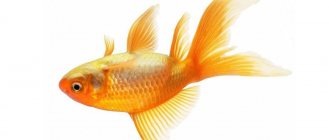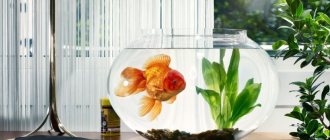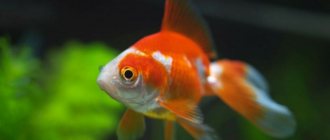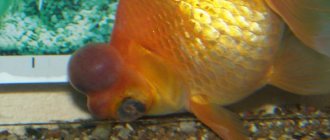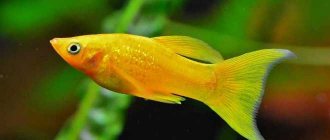How is the goldfish exercise useful? The yoga instructor answers.
The Japanese gave the world not only sushi, but also health systems unlike any other. One of them is offered by healer and aikido teacher Katsuzo Nishi. Doctors predicted an early death for him, but thanks to his technique, he lived to be 75 years old. The scientist believed that treatment should begin with the spine and developed a special “goldfish” exercise.
Woke up and stretched: 5 exercises you can do right in bed
Instead of breakfast in bed: 5 asanas for morning exercises
Description
Different species and morphs of arowana differ in their appearance so much that it is difficult for a non-specialist to determine their close relationship, but there are common characteristics:
- a long, flexible body that curves like a mythical dragon or moray eel;
- a large, obliquely located mouth , which makes the fish’s face very similar in profile to a lizard, is capable of opening so wide that the arowana can swallow significant prey - cicadas, crickets and even small birds, frogs;
- the tongue has a clearly visible row of teeth, for which the fish got their name;
- the teeth are located on the vomer, palatine and pterygoid bones;
- there are fleshy tactile antennae on the lower jaw;
- the area on the throat may swell greatly, forming a voluminous pouch;
- scales are large, durable;
- the dorsal and anal fins are low, almost merging with the caudal fin;
- pectoral fins are also small but strong;
- the eyes are large, with a clearly defined pupil, protected by a fold of skin.
Keen eyes can see equally well above and under water. The dorsal and anal fins merging with the caudal fins, shifted strongly back, form a powerful “oar”, which helps the fish not only swim quickly, but also powerfully jump out of the water to a height of up to 1 m.
Under natural conditions, fish grow up to 1.2 m. In artificial reservoirs they are smaller - about 90 cm. Since in the natural reservoir where arowana is found there is little oxygen, nature has provided an auxiliary breathing system - a swim bladder.
Diseases
The scarlet barb, like all members of the genus, has good immunity. Under favorable conditions, the fish practically does not get sick. But neglect of simple maintenance rules can lead to various kinds of diseases and even cost the life of any aquarium animal.
A viral, bacterial infection or parasitic form of protozoa introduced into the aquarium can cause in barbs:
- Ichthyophthyriosis. The causative agent is ciliated ciliates. A common infectious disease. It spreads quickly in the aquarium and appears as white dots and bumps on the cover (semolina effect). For treatment, table salt, potassium permanganate, copper sulfate, formalin, pharmaceuticals (tripaflavin, bicillin-5) or commercial drugs (TetraMedica Contralck, Sera Costapur, etc.) are used. For the period of therapy, increase the water temperature by 2-4 °C and increase aeration.
- Fin rot. Bacterial or parasitic infection of the cartilaginous swimming organ. In other cases, it occurs from traumatic factors, ammonia burns. It manifests itself as drooping, uneven edges, and over time - necrosis of the fin tissue. How to treat fin rot: hydrogen peroxide, streptocide, malachite green, furatsilin, chloramphenicol, etc.
- White-skinned. A bacterial disease manifested by the formation of white areas on the integument in the area of the dorsal and caudal fins. Over time, the overall color becomes pale and the central nervous system is affected. Treatment is carried out in the early stages with chloramphenicol.
Barbs are white-skinned
Fin rot
Fish affected by ichthyophthyriasis
The gluttony of scarlet barbs can cause obesity. This condition can significantly shorten the lifespan of any fish and provoke a whole range of associated pathologies. It is important to take a rational approach to the process of feeding barbs, defining one fasting day per week.
Aquarium lighting and filtration reduce the therapeutic effect. Medicines decompose faster from lamps, and filters with sorbing elements neutralize them.
Types of arowana
The species have slight differences depending on their area, so they are divided into:
- Asian, having several colors: red, purple, blue, gold, green, red-tailed, black;
Red Asian Arowana
- Australian, of which there are 2 subspecies: pearl arowana Giardini or pink-scaled scleropagus; spotted arowana or red-spotted barramunda;
Australian Pearl Arowana
- South American also has 2 subspecies: silver (true) arowana, black arowana.
South American Silver Arowana
The Asian arowana has practically disappeared from natural conditions, where it lived in lakes, swamps, and floodplains of rivers overgrown with dense vegetation with a very slow flow. Some morphs lived in black water, the color of which was given by fallen leaves and peat.
The most expensive fish is the Asian one - the Malaysian scleropagus. Uncontrolled fishing of this relic has brought the fish to the brink of extinction. In addition to tasty meat, this river giant in the Taoist practice of Feng Shui is considered a talisman that can bring good luck in business, wealth, and keep evil out of the home.
In addition, the appearance of the Asian Arowana is unusual - shining like a gold bar Premium High Gold or shining purple Super Red Arowana. Some copies cost $150,000. Since 1975, Asian Arowanas have been included in the CITES Convention. A limited number of legendary fish are sold with a certificate and an implanted chip confirming their artificial origin.
Macrognathus ocellata: history
The aquarium eel is another name for macrognathus: its flexible body, with its outlines, is entirely reminiscent of an electric eel, only in a smaller version.
Macrognathus belongs to the order Perciformes, suborder Proboscis snouts (Mastacembelidae) , which includes two subspecies:
- macrognathus;
- mastacembela.
Despite the external similarity, it is easy to distinguish relatives: mastacembela, even in an artificial reservoir, can grow more than half a meter in length .
Since the mid-80s of the twentieth century, Soviet aquarists began to breed macrognathus.
What difficulties may there be in the content?
There is no particular difficulty in keeping an arowana. These ancient fish are practically omnivorous, tolerant of oxygen levels in the water, but they require a large volume of home pond. The length of the aquarium should be at least 1.2 m. It can be small in height (~ 60 cm), but the volume per individual should be 250 liters.
Fish do not tolerate fluctuations in water characteristics well, so you should not introduce arowanas into an unseasoned aquarium. In addition, fish are frightened by sudden flashes of light.
Features of feeding
Under natural conditions, these relict fish are predators that not only lie in wait and quickly pursue small fish and amphibians, but also hunt aerial and terrestrial insects and small mammals. Seeing small birds sitting on overhanging branches or large insects flying by, the fish powerfully pushes off from the water column and jumps high into the air, grabbing its prey with its huge mouth.
Therefore, in an aquarium they can be fed with live grasshoppers, crickets, marbled cockroaches, gammarus, both live and frozen. Dragon fish happily eat live baby frogs and small fish, but you should be sure that the food is completely sterile, otherwise your expensive fish may become infected with parasitic diseases.
Large fish are fed with pieces of chicken, strips of fish and even small mice. However, it is worth considering that a monotonous diet with a predominance of protein foods leads to obesity and liver diseases. The diet should be varied, including dry, freeze-dried and frozen food. The only condition when feeding ready-made food should be its “buoyancy”, because fish are only interested in floating food. The one that fell to the bottom is not seen by the fish - this is how their organs of vision are designed.
Reviews
Scarlet barbs are unpretentious fish that even a novice aquarist can keep and care for. Considering the endurance, energy and attractive appearance of the fish, many water enthusiasts acquire scarlet puntius, happily breeding these fish at home.Have you kept scarlet barbs? Would you like to start one? Share your thoughts in the comments.
Keeping in an aquarium
This type of fish requires a long, not very high aquarium, where the long arowana can swim freely. Fish have a very strongly developed territorial sense, so if there are several individuals, then they need a lot of space so that crowded conditions do not provoke aggression.
Decorative elements and landscaping in the aquarium are optional. It is better to fill the bottom with coarse river sand or small, well-rolled pebbles. The water should be warm, because the fish comes from subtropical waters. Therefore, it must correspond to natural conditions:
- t =24-30°C;
- dH 5-15°;
- pH 6.5-7.5.
Despite the fact that the water in natural reservoirs is poor in oxygen, for comfortable keeping of an arowana it requires active aeration, good filtration and weekly 30% water changes. The stream of water from the filter needs to be distributed along the bottom so as not to create a strong current - the fish are not used to it.
If, nevertheless, the owner decides to decorate his home pond with green plants, then experts recommend planting it with plants with a good root system and burying it deep into the ground, otherwise fish may tear out the plantings. Another convenient way is to garden with plants in pots. It is better to place them around the perimeter of the reservoir so that they do not interfere with the fish’s swimming.
The aquarium must be covered with durable glass, since arowanas, which easily jump to a meter height, can fall out. Special lighting should also be provided - adjustable incandescent lamps or dimming with the help of plants floating on the surface.
Compatibility
When choosing neighbors for scarlet barbs, it is important to remember the mobility of these wonderful fish. Puntiuses can cause a lot of trouble for slow and dignified phenotypes, constantly pestering their roommates.
Despite their mobility and lively nature, barbs themselves can become dinner for predatory fish, so co-population of punts with aggressive and large phenotypes should be avoided.
Compatible
Scarlet puntius demonstrates good compatibility with related species: fiery, Sumatran. A cherry barb or a Schubert barb will look especially impressive in an aquarium with scarlet. Its bright red dorsal fin will add contrast in a school of tiktos.
The cherry color of barbs looks bright and rich in the aquarium.
Scarlet barbs are also kept with other peace-loving fish:
- mollies;
- Congo;
- tetras;
- zebrafish;
- neon;
- labeo;
- swordtails;
- irises.
Large snails can also keep barbs company; fish will eat small mollusks.
Not compatible
Barbs often show hooligan tendencies - they bite the mustache and lush fins of representatives of a multi-species aquarium.
Compatibility table for barbs with other fish
Not recommended for keeping:
- large, aggressive predators;
- cockerels;
- angelfish;
- guppy;
- goldfish;
- gourami.
Small bottom fish are well compatible with barbs, but large catfish pose a threat to them.
With whom can Arowana be combined?
Arowana is a predator that occupies the upper layers of water, capable of loitering in the water column for a long time or quickly rushing at prey. You should not hope that animals smaller in size than the arowana will peacefully coexist with it in the same aquarium.
Arowana will share water spaces only with individuals of equal size or larger ones. They coexist well with stingrays - they not only have the same food preferences, but also different “levels”. This way they will not intersect and conflict. Also, large loaches, brocade catfish, and large angelfish will not be eaten. If the volume of the aquarium allows, and the arowanas are well-fed, then there is no need to worry about the integrity of the neighbors.
Interesting Facts
Until the wild species was discovered in its natural habitat, the scarlet barb was considered a hybrid form.
In captivity, puntius are capable of:
- briefly withstand low and high water parameters from 16 to 30 ° C;
- in a pack, show a minimal level of aggression and experience stress less often;
- form a clear hierarchy in a group of relatives;
- acquire a feeding reflex if they are given food at the same time.
In female scarlet barbs, fertility is 150-200 eggs; individuals that do not lay eggs become infertile.
Sex differences
Sexual dimorphism in arowanas is as follows:
- smaller body sizes of females;
- males have a larger head and a somewhat lower and slimmer body;
- brighter color of males;
- in males, the lower lip covers the upper lip to prevent loss of eggs during incubation;
- more aggressive nature of males and strong competition when eating;
- The anal fin of the male is larger and has a more pointed shape.
Sex differences are absent in fry. Dimorphism begins to appear only at the beginning of puberty.
Pregnancy period
The embryos develop in the female's abdomen over 4-6 weeks. The gestation period depends on the age of the “mother” and the temperature of the water in the aquarium. Next, we will tell you how to determine the pregnancy of a female guppy by her appearance and behavior, and also consider the nuances of preparing for childbirth.
Determining pregnancy in guppies
In the early stages, the pregnancy of a female guppy cannot be determined, and it is difficult to tell whether fertilization has occurred. But every day the female’s belly grows, rounds, and her back bends. The guppies' appetite increases. She tries to hide deep in the thick of plants, often sinking to the bottom and licking the muddy sediment. This food supplement serves as a source of microelements that fry need.
By the end of the gestation period, the guppy's abdomen swells significantly and takes on a rectangular shape. A so-called “step” appears between the stomach and head - a sharp drop that indicates a normally developing pregnancy. A dark spot appears in the lower abdomen, the anus increases in size.
Is it necessary to remove the female for childbirth?
For a pregnant fish, changing place of residence is stressful. There are cases of delayed birth in released fish. When you don’t want to interfere with the natural process, you can leave the female in her usual environment and not take any action. However, if breeding guppy is your goal, it is recommended to move the female to a nursery during the birth. The fact is that in wild guppies, after birth, the fry are immediately carried away by the current, but in a home aquarium there is a closed space. Waterfowl look at the miniature fish as food, and even parents can eat their offspring.
Attention! A special tray - a depositor, placed in the aquarium, will save the situation. And the pregnant fish will be able to feel at home, and the babies will be safe. It is easier to place the female in time than to later catch the newborn fry with a glass.
Prenatal behavior and childbirth
Feeling the approach of childbirth, the female tries to move less, because of this she freezes. In search of warmth, it stays close to the heater. She takes in little food and often belches food. At the beginning of spawning, the guppy freezes and its tail trembles slightly. The fry appear one after another, some immediately break the shell and begin to swim, others lay down on the bottom. This is normal - after some time they will gain strength. To prevent a tired mother from eating her fry after giving birth, she must be immediately returned to the general aquarium.
How many fry can be born
It is very difficult to calculate how many fry were born, because they are in constant motion. The number of fish depends on the condition of the female:
- her age;
- size;
- having childbirth experience.
If the female guppy is young, pregnant for the first time, she will give birth to no more than 20 fry. In its prime, the fish gives birth to 50-100 babies.
How to breed arowanas
Sexual maturity in various species of arowana occurs by 3-4 years, when the body length of the fish is 45-60 cm. The female has only one ovary, which produces 50-60 eggs at different stages of development. A sexually mature male also has only one filamentous testis. The eggs are large - the diameter of the eggs can reach 1.9-2 cm.
During the period of readiness to breed, the male arowana demonstrates very special sexual behavior. Courtship of the female lasts from several weeks to several months before the start of spawning. As a rule, at night the male begins to actively pursue the female, swimming close to the surface in wide circles.
If the female has accepted courtship, then together with the male she begins to look for a comfortable and secluded place for spawning. The male swims next to her, rubbing against her until she releases the first portion of eggs. The male fertilizes it and places it in his mouth for incubation. This happens several times. Ripening lasts 7 days.
The hatched larvae continue to remain in the oral cavity until the yolk sacs are completely reabsorbed (7-8 weeks). Only when the fry are able to feed on their own does the male release them into the water. The body length of the fry by this time already reaches 45-50 mm.
In nurseries, fry begin to be fed with larvae of mosquitoes, livebearers - guppies, mollies, swordtails. The hunting instinct awakens in babies, forcing them to chase and eat live food. Already at this stage, aggressive behavior of large individuals is noted. So that they do not leave the babies hungry, the fry are separated. To increase the color intensity, aquariums with juveniles are illuminated for at least 10-12 hours a day.
The most unique arowana on display was an albino arowana, owned by the famous fish breeder from South America - Aro Dinesti. At an exhibition in Singapore, he was offered $80,000 for a specimen without a single spot. But the owner refused to sell his treasure even for such a significant amount.
Reproduction and lifespan
Arowana spawning takes place in winter. During December or January spawning, a female can lay up to 200 eggs, but only 15-30 fry survive out of the total offspring. The size of the yellow eggs is 15 mm in diameter. The male also actively participates in the preservation of offspring. After laying eggs, it collects the offspring in its mouth, where the incubation period subsequently occurs.
For 50 days, he carefully carries the eggs. After the eggs hatch into larvae, he continues to incubate them in his mouth until the stomach pouch of each is dissolved. Only after this, the fry will be able to feed on their own. By the time they live independently, the fry manage to grow up to 10 centimeters.
In the wild, the life expectancy of arowanas can exceed 60 years, as their health is rarely affected by viruses. However, aquarium specimens live no more than 15 years. No matter how hard a person tries, the artificially created conditions of an aquarium are unsuitable for such a long life.

